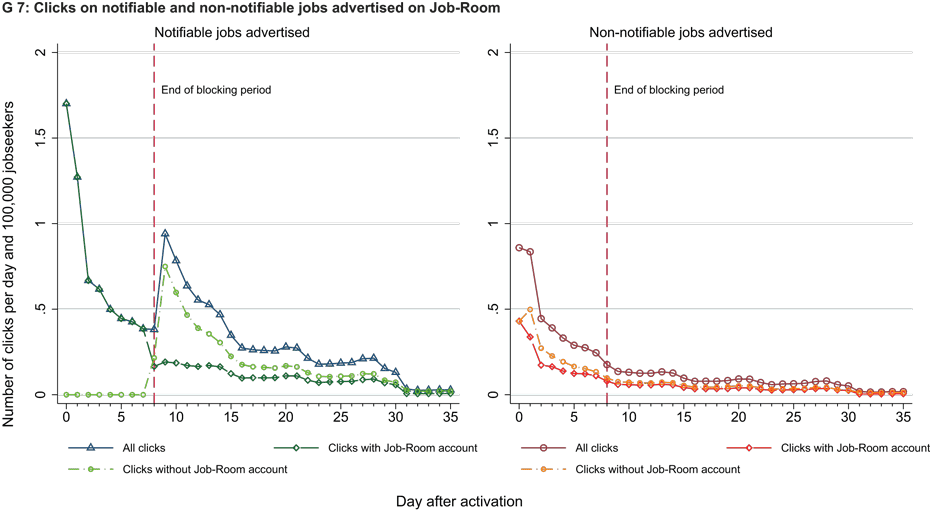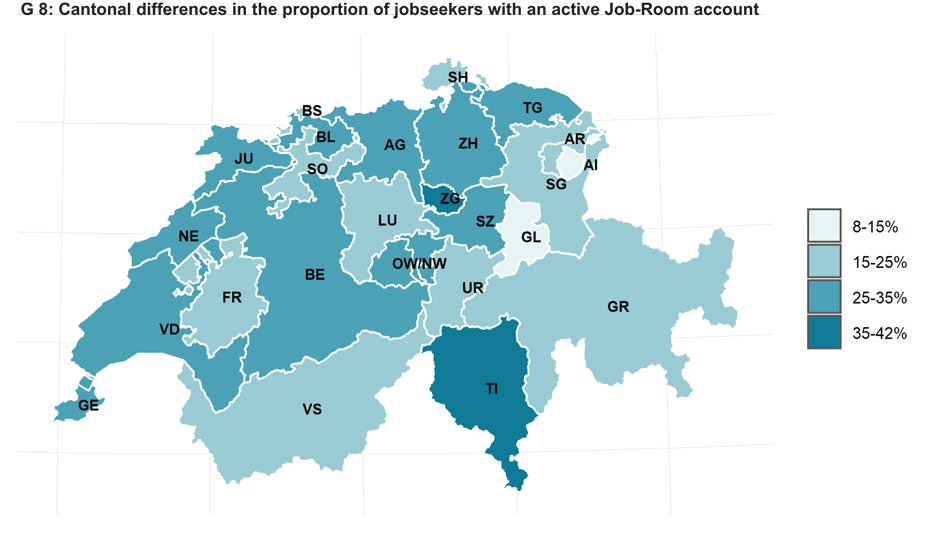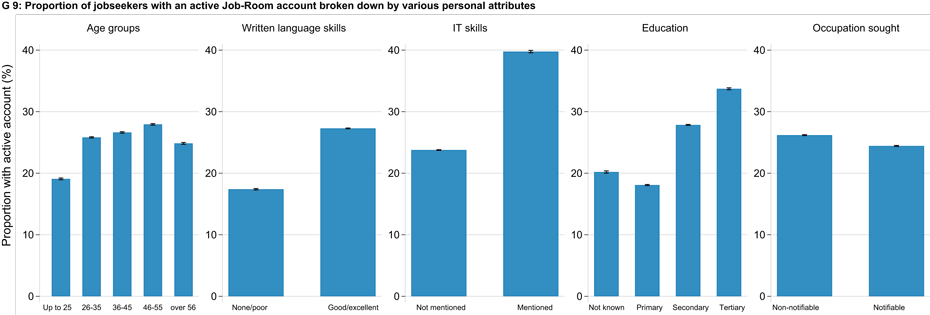Digital divide? An analysis of the usage data from the Job-Room online job platform
- Labour Market
- KOF Bulletin
In a study conducted for Switzerland’s State Secretariat for Economic Affairs (SECO), KOF has examined the use of the Job-Room.ch online job platform within the context of the introduction of mandatory job notification. It shows that people without IT skills, with little knowledge of the local language or with low levels of education are at a disadvantage.

Digitalisation is inevitably changing how workers and companies find each other. A key element of this are online job platforms, a kind of dating platform on which individuals can search for vacancies and firms can look for suitable candidates. Economists have high expectations of such online job platforms. They hope that they can help jobseekers to find the positions that suit them best more easily and quickly in what is a confusing labour market. Equally, matching jobseekers to jobs better could reduce search time, lower unemployment and even increase firms’ productivity. Such productivity gains would also benefit workers in the form of higher wages. That’s the theory at least. But what if access to, and navigation of, such platforms were actually made more difficult for people with moderate IT or language skills? Could it be that, in this case, platforms are more likely to create new digital divides and even reinforce inequalities in the labour market instead of having an integrative effect?
What we can learn from the job notification requirement on online job platforms
In a study conducted for Switzerland’s State Secretariat for Economic Affairs (SECO), KOF has examined the use of the public employment service’s Job-Room.ch online job platform, one of the leading Swiss online job platforms, within the context of the introduction of mandatory job notification. The use of external page Job-Room became particularly attractive for many people who were registered as jobseekers with a regional employment office (RAV) when mandatory job notification was introduced on 1 July 2018. This stipulated that, from this date, employers were required to report all vacancies in occupations with high unemployment rates (typically over 8 per cent) to the RAVs. These jobs were then posted in a login-protected area on Job-Room and could not be advertised elsewhere during a blocking period of five working days. This gave jobseekers registered with the RAVs who had set up a login to this protected area on Job-Room an information advantage over all other jobseekers. By granting this information advantage, the Swiss parliament – which implemented its mass immigration initiative in parallel with the job notification requirement – was seeking to harness domestic labour potential better. In their study the authors analyse, among other things, whether this information advantage was utilised at all and which jobseekers gained access to the login-protected area of Job-Room.
Information advantage during blocking period is utilised
To provide answers to the first question, the study uses data on nearly 300,000 jobs (both notifiable and non-notifiable ones) posted on Job-Room between 1 July 2018 and 31 December 2019 as well as the total of 5.5 million clicks registered for these jobs. Chart G 7 shows the average number of times a job posting was clicked on per day since it had been posted on Job-Room. The authors of the study distinguish between notifiable job postings (left) and non-notifiable ones (right). In order to make both types of job notification comparable, the number of clicks per day was normalised with the number of jobseekers registered for the job concerned. In addition, it is possible to distinguish clicks by individuals with access to the login-protected area of Job-Room from those who do not have such access. Finally, the chart also shows the blocking period during which notifiable job announcements can only be accessed in the protected area of Job-Room. Because the five working days always include a weekend, the information advantage effectively lasts until the seventh day after the job has been activated.

This chart enables initial conclusions to be drawn about the use of the information advantage:
- The chart shows that most clicks for both types of job postings occur during the period immediately after the jobs have been activated on Job-Room. After that, the number of clicks very quickly tends towards zero. A job posting is hardly ever clicked on after the 30th day. More than 50 per cent of job postings are no longer clicked on after the third day. The five-day blocking period is therefore a relatively long period compared with the time jobseekers usually spend looking at job advertisements on Job-Room.
- Notifiable job announcements receive more clicks per day than non-notifiable jobs. Cumulating the average number of clicks per day, notifiable job announcements receive more than twice as many clicks as non-notifiable job announcements by day 35 (14 clicks – compared with six clicks – per 100,000 jobseekers)
- There are two peaks for notifiable job announcements: the first occurs on the day on which a job is activated, and the second comes on the ninth day after activation or just after the end of the blocking period. A breakdown into clicks by people with a Job-Room account and those without an account shows that the first peak is exclusively due to individuals with a Job-Room account. This is to be expected since notifiable job announcements can only be viewed by jobseekers with a Job-Room account. Accordingly, the light green line shows that individuals without a Job-Room account do not click on notifiable jobs during the blocking period. However, their clicks skyrocket after the blocking period, which explains the second peak. Cumulative clicks by those without an account still represent about 40 per cent of the total clicks per notifiable job posted on Job-Room.
Overall, it can be seen that job advertisements on Job-Room are definitely used – especially during the first few days after activation. Notifiable jobs experience two peaks in their intensity of use: the first one just after they have been activated by individuals who can log in to the protected area, and the second one by those who cannot log in just after the end of the blocking period. The latter peak could also be attributable to people who would be entitled to log in to the protected area of Job-Room but who are not aware of this fact and have therefore not yet registered for login access.
Who makes use of the information advantage and who does not?
This brings us to the question of which jobseekers actually gain access to the protected area of Job-Room in order to benefit from the information advantage. The answer to this question also provides information on whether there is a digital divide on the platform. To do this, we use data from all individuals who were registered as jobseekers and those jobseekers registered with an RAV from 1 July 2018 to 31 December 2019 as well as their login activity on Job-Room.
This analysis shows that only a minority (25 per cent) of jobseekers open an account for the protected area of Job-Room or register for login access. Although this proportion increased steadily during the first year-and-a-half after the job notification requirement came into force, it was still less than 40 per cent in the final quarter of 2019. There are significant cantonal differences here: in Ticino the proportion of jobseekers with an active Job-Room account was around 4.5 times higher (42 per cent) than in Appenzell Innerrhoden (9 per cent).
Multivariate analysis of personal attributes with respect to Job-Room login usage reveals a few surprising findings and a few expected ones as well:
- Differences with respect to knowledge of the written local language, IT skills and education are more likely. Chart G 8 shows that IT skills and good or excellent written knowledge of the local language significantly increase the probability of using the protected area of Job-Room and thus of benefiting from the information advantage. It also reveals that people with higher levels of education make significantly greater use of this area.

- One rather surprising finding, however, is the differences in use with regard to age. Jobseekers between 45 and 55 years of age reveal the highest probability of use, while jobseekers under 25 years of age show the lowest probability. This result contradicts the commonly held opinion that internet-based job search channels are mainly used by younger jobseekers.
- Surprisingly, the information advantage does not seem to contribute significantly to opening a Job-Room account. For example, people who are looking for jobs in a notifiable occupation or who have previously worked in such an occupation are only slightly more likely to use the protected area of Job-Room. A detailed examination in the study also reveals widely dispersed Job-Room use within both occupational groups.
- Figure G 9 Differences Individuals: Bar-charts with confidence intervals on the average use of the following characteristics: IT and language skills, education, age, ev. reportable and non-reportable occupations.

What do we learn from this?
Overall, these evaluations reveal a mixed picture with regard to use of the information advantage on the Job-Room public online job platform.
- Notifiable job advertisements that are only published in the login-protected area on Job-Room up to the blocking period are frequently viewed during the blocking period but also register many new clicks after this period. This latter aspect could partly be attributable to people who are entitled to an account in the protected area but do not know about it or are unable to use it satisfactorily.
- Analysis of login activity indicates that – at least when the job notification requirement was first introduced – the information advantage cannot have been the most important reason why jobseekers opened and used a Job-Room account. A supplementary evaluation shows, however, that an information campaign by the RAVs and the simultaneous removal of technical obstacles increased the use of Job-Room by precisely those jobseekers who could benefit most from the information advantage.
- Finally, there is some evidence of a digital divide in the use of the login-protected area. People without IT skills, with little knowledge of the local language or with low levels of education use the protected area of Job-Room significantly less. These people also tend to have less chance of finding a job in the labour market. Consequently, the Job-Room online job platform could further reinforce existing inequalities in the labour market and make the integration of disadvantaged groups even more difficult (see: 'What clicks on a job platform reveal about discrimination'). Simplifying access and use for these groups is therefore an important focus for future changes to the design, technical access barriers and information campaigns on the use of Job-Room.
You can find the KOF-BSS study on the job notification requirement external page here (in German).
Contact
KOF FB KOF Lab
Leonhardstrasse 21
8092
Zürich
Switzerland